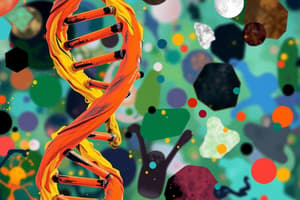Podcast
Questions and Answers
What is a nucleotide?
What is a nucleotide?
- A subunit that consists of a sugar, a phosphate, and a nitrogenous base (correct)
- An enzyme that catalyzes DNA synthesis
- A shape of DNA
- A virus that infects bacteria
What is a nitrogenous base?
What is a nitrogenous base?
An organic base that contains nitrogen, such as a purine or pyrimidine.
What is the shape of DNA?
What is the shape of DNA?
Double helix
What is DNA polymerase?
What is DNA polymerase?
What is a bacteriophage?
What is a bacteriophage?
The nucleotide in DNA consists of a sugar (deoxyribose), one of four bases, and a phosphate.
The nucleotide in DNA consists of a sugar (deoxyribose), one of four bases, and a phosphate.
What are the base pairing rules in DNA?
What are the base pairing rules in DNA?
What are the monomers of DNA?
What are the monomers of DNA?
Which of the following are the four different types of nucleotides?
Which of the following are the four different types of nucleotides?
Flashcards are hidden until you start studying
Study Notes
Key Terms and Definitions
- Nucleotide: Basic subunit of nucleic acids; composed of a sugar, phosphate, and nitrogenous base.
- Nitrogenous Base: Organic compounds containing nitrogen; includes purines (adenine, guanine) and pyrimidines (cytosine, thymine).
- Double Helix: The structural shape of DNA, resembling a twisted ladder.
DNA Structure
- DNA Polymerase: Enzyme that facilitates DNA replication by adding nucleotides at the replication fork.
- Bacteriophage: Type of virus specifically targeting bacteria.
Composition of Nucleotides
- Each DNA nucleotide is formed of:
- Sugar: Deoxyribose
- Bases: One of four types—adenine (A), thymine (T), cytosine (C), guanine (G).
- Phosphate Group: Forms part of the DNA backbone.
- Nucleoside: Combination of sugar and nitrogenous base.
DNA Molecule Structure
- DNA is categorized as a macromolecule, having a complex structure formed from smaller subunits (nucleotides).
- Appearance: Twisted rope ladder (double helix), with consistent sides (sugar-phosphate backbone) and varying rungs (base pairs).
- Base pairs:
- Adenine (A) pairs with Thymine (T)
- Cytosine (C) pairs with Guanine (G)
- Variability of rungs encodes genetic information.
Base Pairing Rules
- Adenine (A) with Thymine (T): A purine always pairs with a pyrimidine.
- Cytosine (C) with Guanine (G): Consistent pairing due to chemical affinity.
Monomer Details
- Nucleotide Composition:
- 5-carbon sugar: Deoxyribose
- Phosphate group
- Nitrogenous base (A, T, G, C)
- Nucleotides connect to form the DNA backbone and dictate structure through specific base pairing, resulting in the iconic double-helix shape.
Studying That Suits You
Use AI to generate personalized quizzes and flashcards to suit your learning preferences.




